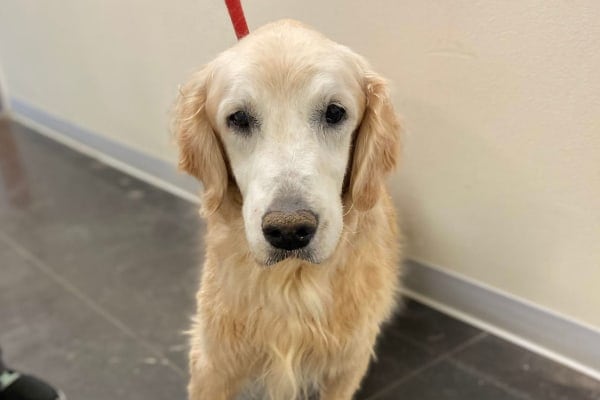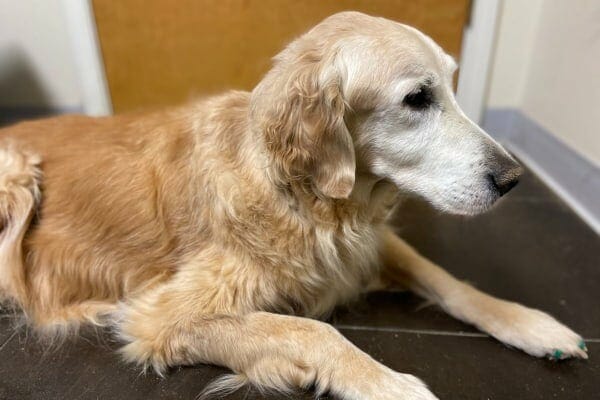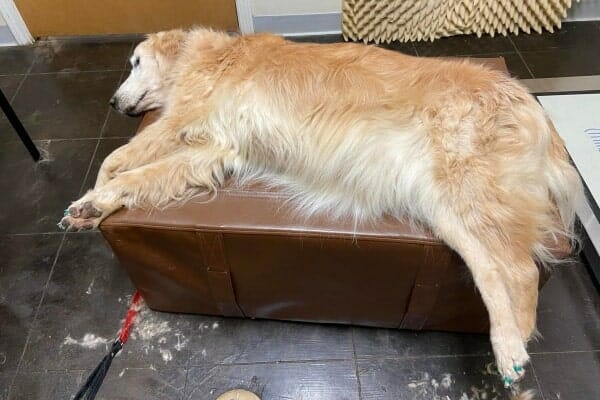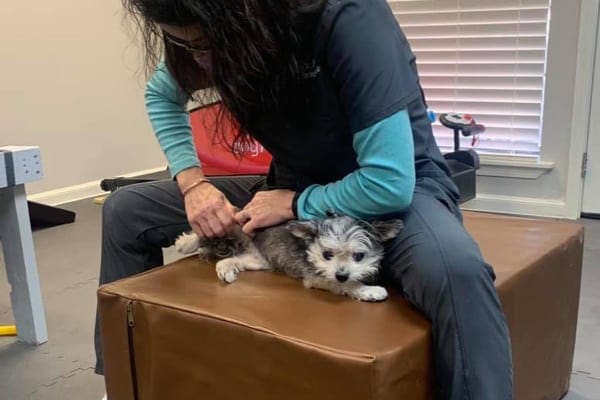
You may rely on a chiropractor to treat your aches and pains, but did you know a “dog chiropractor” can do the same for your canine companion? Dr. Sonya Brouillette — graduate of the Parker University Animal Chiropractic Program, veterinarian, and friend of Dr. Julie Buzby — shares the ins and out of chiropractic care for dogs. By learning what “canine chiropractors” do, you’ll be able to understand the role that chiropractic care can play in the health and well-being of senior dogs.
If you’ve experienced the benefits of visiting a chiropractor yourself, it’s only natural to wonder if your dog would benefit from a chiropractor, too. After all, if an adjustment can put the spring back in your step, maybe it can also help another member of your family — your senior dog.
I am passionate about providing chiropractic care for animals and have witnessed the immediate and restorative results. But before I tell you about the ins-and-outs of dog chiropractic care, let me show you the results by sharing the story of one of my dear canine patients, Buffy.
A 14-year-old Golden Retriever benefits from chiropractic care
Buffy is a 14-year-old Golden Retriever who struggles to get up and down, slips and slides on hard-surface floors, and just recently began chewing on her back leg. She has a history of hip dysplasia and has been progressively slowing down over the past year. Buffy was already taking joint supplements and standard canine arthritis medications, which can help relieve arthritis pain in dogs.

Like many of my clients over the years, Buffy’s concerned owner asked, “What else can we do to help her?” Luckily for Buffy, she was a patient at the clinic where I perform veterinary chiropractic. The wonderful veterinarians there immediately recommended an appointment with me to see if I could help to relieve her arthritis pain. Stick around — you’re going to want to hear how much Buffy liked her chiropractic adjustment!
Who can be a “dog chiropractor”?
Now that we have established that dog chiropractors do indeed exist, let’s take a look at who might hold the title. Licensed veterinarians and human Doctors of Chiropractic Medicine can complete a rigorous training program to become an animal chiropractor. Dog chiropractors learn to help dogs as tiny as Chihuahuas and as mammoth as Mastiffs and Great Danes.
It is important to communicate with your dog’s regular veterinarian before seeking chiropractic care and to select a professionally trained and certified dog chiropractor. Your veterinarian will likely have a recommendation for a trusted professional in your area.

What does a dog chiropractor do?
You might be wondering, “How does a dog chiropractor help with joint pain or other problems? What exactly is chiropractic care anyway? Can it help my dog?”
To fully answer those questions, it’s important to understand how your dog’s nervous system works.
Canine nervous system basics
Think of your dog’s brain as “command central” and his spinal column as the “superhighway.” This highway leaves the skull and runs down the length of the spinal column. At every single vertebral space, nerves exit and enter the spinal column. These act like exits on the interstate, carrying nerve impulses from the brain to the internal organs, muscles, joints, and skin.
The spinal cord “superhighway” also has nerves that function as entrance ramps, allowing information collected from the body to make its way back to the brain.
Dog chiropractors mobilize joints
Each joint moves slightly to collectively allow a full range of motion to the body. When a single joint loses that tiny bit of mobility, the nerve near that joint can become irritated, causing a pain sensation along the length of that nerve.
This pain signal then travels to the spinal cord then to the brain, where it is perceived as pain. Remember, dogs don’t always whine or cry out when they are in pain. If you’d like to learn more about this common misconception, please see Dr. Buzby’s article: 7 Signs Your Dog is in Pain.
Dog chiropractors detect those tiny areas that have lost motion causing interference within the nerve pathway. A chiropractic adjustment restores that mobility and allows the nerve impulses to run freely once again.

Understanding chiropractic adjustments for dogs
Initial chiropractic adjustments can be uncomfortable because those restricted joints are sore and painful. As a dog chiropractor moves through each joint, restoring range of motion, the nervous system begins functioning at full capacity again. This gives the dog immediate relief.
You will see the dog’s face and eyes relax, and many times they give a big shake because they want to “reset” their nervous system.

Visiting a dog chiropractor isn’t the only way to restore joint function and encourage mobility. Learn about passive range of motion exercises for senior dogs you can do at home to preserve your dog’s mobility too.
Chiropractic adjustments for dogs with hip dysplasia
Now, remember Buffy? When she first came to me, she could not bend her nose to her ribs on her left side. She had restricted motion along her spine, and she had lost much of her range of motion in her hips.
Hips can be painful, as there are large nerves running through that area. Restricted movement leads to a buildup of scar tissue and inflammation causing more pain and preventing normal movement. It becomes a self-perpetuating cycle.
A dog chiropractor will typically work through every joint in the leg, starting or ending in the toes, correcting and restoring motion in each joint. The hip itself is where the biggest bone in the body, the femur, connects to the pelvis. It is a large area with a lot of movement. A dog chiropractor will restore as much movement to that joint as possible relieving tension on the nerves and increasing blood supply to the area.
Buffy’s chiropractic adjustment
Have you ever had a deep tissue massage and wanted to simply sleep for a while? That is exactly what Buffy did. Once she received her entire adjustment, she did not want to get up. I had “mobilized” so many of her “restricted” joints, which in turn gave her nervous system so much release, that she took the best 15-minute nap of her life after I’d finished!

To keep her joints moving confidently and prevent further damage, I shaved the hair between Buffy’s toes and added ToeGrips® dog nail grips. Dog chiropractors, myself included, also love to use kinesiology tape to help hold the chiropractic adjustment longer.
Buffy benefited from her chiropractic adjustment so much that her owners jokingly said, “No more chiropractic adjustments! She is running around like a young crazy dog again, and we can barely keep up!”
Who can benefit from a dog chiropractor visit?
Any and every dog will benefit from a chiropractic adjustment. I have corrected minor misalignments on young puppies who play too hard, fall downstairs, run into walls, and all the other precarious puppy situations.
Agility dogs and working dogs can stay in optimal health by seeing a dog chiropractor every two to three months for routine maintenance.
Senior dogs certainly benefit from having their joints adjusted on a routine basis. Canine chiropractic adjustments can be part of a management plan for:
- Hip dysplasia
- IVDD in dogs (intervertebral disc disease)
- Neck or back pain
- Traumatic injuries
- Osteoarthritis
- Job-related injuries (service animals or working dogs)
- Other joint, muscle, or nervous system disorders
To learn if your dog is aging or if it’s osteoarthritis, please see Dr. Buzby’s article: Is It Aging or Canine Arthritis?
Dog chiropractors can help senior dogs

Most senior dogs have areas of decreased or lost motion, especially with chronic conditions like arthritis, hip dysplasia, and intervertebral disc disease. Restoring motion allows the dog to move more freely and with less nerve irritation (read: less pain).
Dogs who chew on their legs often do so because of nerve pain. Relieving the nerve irritation stops the tingling (similar to the feeling you get when your leg or arm “falls asleep”). Once the leg doesn’t feel full of pins and needles, the chewing behavior often stops.
Another dog chiropractic success story
Every two weeks, I see an elderly girl named Katy. Before she began her dog chiropractic sessions, she could barely walk with her back legs. One leg she tucked and carried along with the other slightly mobile back leg.
Now she uses both legs, jumps out of the car, and plays at the park again. Her owners never go more than two weeks without seeing me because her life is so good when she is adjusted.
Are you searching for canine chiropractic care in your area?
If you’re unsure where to find qualified, certified dog chiropractic care in your local area, please visit the find a doctor search page on the American Veterinary Chiropractic Association’s website.
Nothing to lose, everything to gain
If you are wondering if your dog needs to see a dog chiropractor, the answer is yes! Your senior dog has nothing to lose and everything to gain.

Pause and think about all your dog does during the course of a day: chases birds, squirrels, or other dogs, jumps off furniture, slides on slippery floors, and jumps up on your legs. With these and all your dog’s other high-impact activities, he can benefit from a good relationship with a professionally trained, certified, and caring dog chiropractor.
Just like Buffy and Katy, a visit to a dog chiropractor may change your dog’s life for the better!

Has your canine companion seen a dog chiropractor before?
We’d love to hear about your experience. Please share in the comments below so others can be encouraged!


Tucker, 15 year old Tenterfield Terrier, one day in late December, suddenly had a head tilt, walked in circles, difficulty walking in straight line, bumping in to things. Couldn’t manage stairs. He is hard of hearing and eyesight poor also. He was given meds from vet, little affect. Is there anything that could help, I carry him downstairs for toileting, a little wobbly on his feet and occasionally stumbles. He doesn’t appear to be in pain.
Hi Louise,
I understand your concern for your senior pup and these worrisome symptoms he is displaying. Without examining him myself, it is hard to make specific recommendations. You really need a diagnosis to know what treatments would offer the best possible outcome. From what you describe, I am suspicious he is dealing with vestibular disease. I will attach links to other articles with more information. Have you noticed any improvement? Hoping you can find the answers you need to help restore your sweet boy’s quality of life. Best wishes.
1. Vestibular Disease in Dogs: A True Story About Doggy Vertigo
2. 10 Tips and Exercises for Dogs with Vestibular Disease
3. How to Feed A Dog With Vestibular Disease: A Comprehensive Guide
Yes, my last GSP loved seeing her chiropractor! Be’la was a retired agility star, and she definitely benefited from regular chiropractic adjustments in her senior years. I am bringing my young GSP Trill to our chiropractor next week for a regular check to help prevent issues as she ages.
Thanks for sharing your experience with chiropractic care for Be’la during her senior years and as a preventive measure for Trill. I am so glad that it was beneficial and enjoyable for both of them. ❤